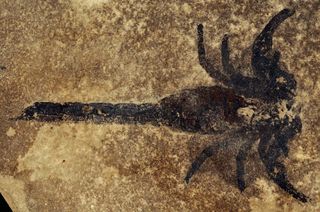Hibbertopterus lamsdelli is only the fourth, yet most reliable record of an American hibbertopterid sea scorpion.

Life reconstruction of a hibbertopterid sea scorpion. Image credit: DiBgd / CC BY-SA 4.0.
Hibbertopterus lamsdelli existed during the Kasimovian age of the Carboniferous period, between 307 and 303 million years ago.
The ancient creature was up to 1.1 m long and probably lived in a marine-influenced estuary fed by a river delta.
Its diet likely included small crustaceans, ostracodes, conchostracans, invertebrate larvae and gastropod eggs.
Hibbertopterus lamsdelli belongs to Hibbertopteridae, an extinct group of aquatic arthropods in the Order Eurypterida.

“Eurypterids, better known as sea scorpions, were diverse (ca. 250 species) Paleozoic aquatic chelicerate arthropods,” said lead author Dr. Simon Braddy and colleagues.
“Generally rare as fossils, eurypterids are locally abundant in American and European Paleozoic Lagerstätten.”
“Most eurypterids with posterior legs transformed into swimming paddles were nekto-benthic predators, and the pterygotids were up to 2.5 m long.”

“Other giant forms include the bizarre hibbertopterids. These broad-bodied, sweep-feeding stylonurids (lacking paddles) grew to more than 2 m long.”
“They were not predators on large prey, like most eurypterids. Their lateral eyes, situated on top of their carapace, indicate they were benthic,” they added.
“It is unlikely that they fed on large prey. Instead, they used their anterior appendages to explore the substrate for shallow, infaunal animals such as small crustaceans and worms.”

Holotype specimen (part) of Hibbertopterus lamsdelli. Scale bar – 4 cm. Image credit: Braddy et al., doi: 10.1080/08912963.2022.2032690.
The fossilized remains of Hibbertopterus lamsdelli were found in the Atrasado Formation at Kinney Quarry, Bernalillo County, central New Mexico.
“It was collected from the top of Kinney Quarry’s bed 3, a 15-16 cm thick, mostly ochre-colored, laminated, bituminous limestone to calcareous siltstone, generally referred to as the ‘fish bed,’ as it yields most of the fish fossils at the quarry,” the paleontologists said.

“The fossil is preserved as a layer of carbonized cuticle and consists of a part and incomplete counterpart.”
“It likely represents a molt (exuvium) transported a short distance and partially telescoped, as it is not completely disarticulated.”
According to the team, hibbertopterid sea scorpions are exceedingly rare worldwide.

The new specimen is only the fourth, yet the most reliable, report from the United States.
“Hibbertopterus lamsdelli is important because these fossils are so rare,” Dr. Braddy said.
“It is also the most reliable American hibbertopterid — this group of giant sweep-feeding eurypterids (sea-scorpions).”
“It was just over 1 m long and similar to Hibbertopterus scouleri, from Scotland, but with a wider body segment before it’s tail-spine, which itself was shorter, with more parallel keels on the underside.”
“These acted like sled rails to reduce body drag when it hauled itself out of the water during seasonal nuptial (mating) walks.”
“We also interpret unusual spines on their legs as acting like a zimmer-frame, to help spread the load, during these excursions.”
Source: sci.news








